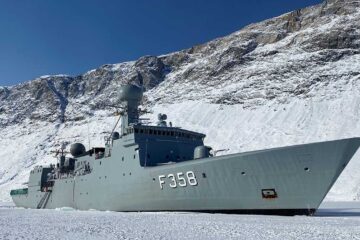Denmark Armed Forces press release – Translation by Naval News
There was an intense but concentrated environment on board when an SM-2 missile was fired from a Danish ship for the first time last night. The whole ship’s crew was stationed at their positions, waiting for the distinctive sound that can be heard throughout the ship when a missile exits the firing well.
All operators in the ship’s combat information center, from where the launch was managed, were completely focused on the task at hand: a safe and successful launch.
However, there was room for a smile on the focused faces when the button was pressed and the missile successfully launched into the sky. The Danish warship has fired an SM-2 missile for the first time, marking the First of Class (FOC) firing, and it was carried out by the frigate Niels Juel under the Ministry of Defence’s Materiel and Procurement Agency. It’s a significant step toward equipping the three Iver Huitfeldt-class frigates with SM-2 missiles.

“It is a significant achievement to have the missiles tested on our Iver Huitfeldt class frigates. When the missiles are deployed on the three frigates in the class, we will be able to use these units for what they were originally purchased and planned for: area air defense. The frigates already have radars and other sensors, as well as a well-trained crew, which allows them to monitor an airspace closely and precisely, as well as detect enemy planes or missiles rapidly. With the SM-2 missiles, the frigates will be able to take down potentially enemy aircraft and missiles from a greater distance, making a substantial contribution to the Danish air force, for example. It simply improves the frigates’ air defense capabilities, which is critical for Denmark’s defense and fulfills NATO’s need.”
Rear Admiral Torben Mikkelsen, Chief of the Royal Danish Navy
When the new missiles are fully phased in, the frigates will be able to deploy quickly for defense tasks in conflict areas throughout the world as well as to defend Denmark and Danish territory.
On the other hand, the upgrading makes the frigates more useful to NATO, as the ability to deploy a ship with sensors and weaponry that can guard airspace is something that NATO is highly interested in. As a result, Denmark’s contribution to NATO will be enhanced.
Long-term project
Prior to the test-fire, the Department of Defence’s Office of Materiel and Procurement (FMI) prepared to install and test the missile over several years. The procurement consists of several parts. The missile itself is being procured through the U.S. Navy. In addition to procuring the missile, a great deal of work has been done at FMI to upgrade the electronics and software aboard the frigate so that the missile can be integrated with the ship’s other systems.
Likewise, FMI prepared the MK41 launcher, which has been installed in the ships from the beginning and from which the missiles are fired. During the land phase, a storage room and a workshop for the missiles were set up at the same time.

“We have worked for many years towards being able to implement this capacity. It is therefore a great pleasure that all that everyone has worked towards went up into a higher unit at a very successful first shot last night. Now we look forward to being able to use the data we have from the test launch to the further work towards a final implementation of the missile system.”
Anders Skeel Bytzau, PM for the SM-2 acqusition at the MoD Materiel and Procurement Agency
Area air defense with SM-2

The capabilities of the new missiles will be to contribute to an area defense.
“Area defense is crucial for a naval force or an aircraft carrier group to operate freely. With the SM-2 missiles, the Danish frigates can much better escort other ships and protect a naval force, and the area the naval force is in, against enemy missiles or aircraft, ” says Captain Simon E. Schultz-Larsen, the commanding officer of the Niels Juel.
The Niels Juel is the first Danish frigate to fire a SM-2 missile. The missile launch is a test to see if all systems are working properly and interacting, which took place at a firing range at sea at Andôya Space Defense (ASD) in the northern part of Norway.
“When we get the missiles tested, it is not only a milestone for Denmark and Danish defense, it is also a big event for the ship and the crew. We have clearly been looking forward to the test-fire, and the crew has been working intensively and purposefully for a long time towards the events of the night. We now have a capability on board that puts the frigate Niels Juel and our sister ships well ahead in terms of naval usability for Denmark and NATO. The Niels Juel has a dedicated and professional crew – and I am proud of their approach to the task.”
Captain Simon E. Schultz-Larsen, the commanding officer of the Niels Juel






